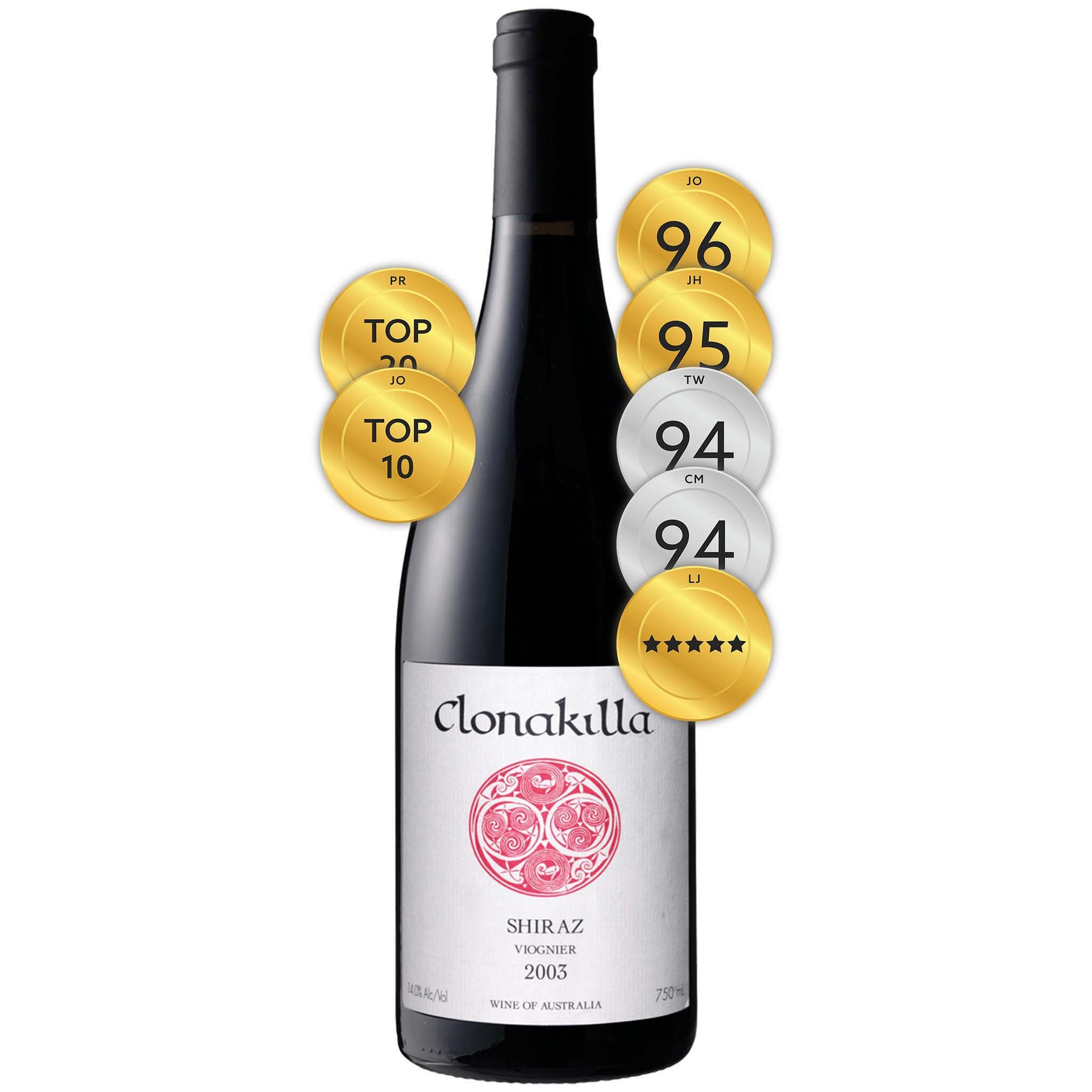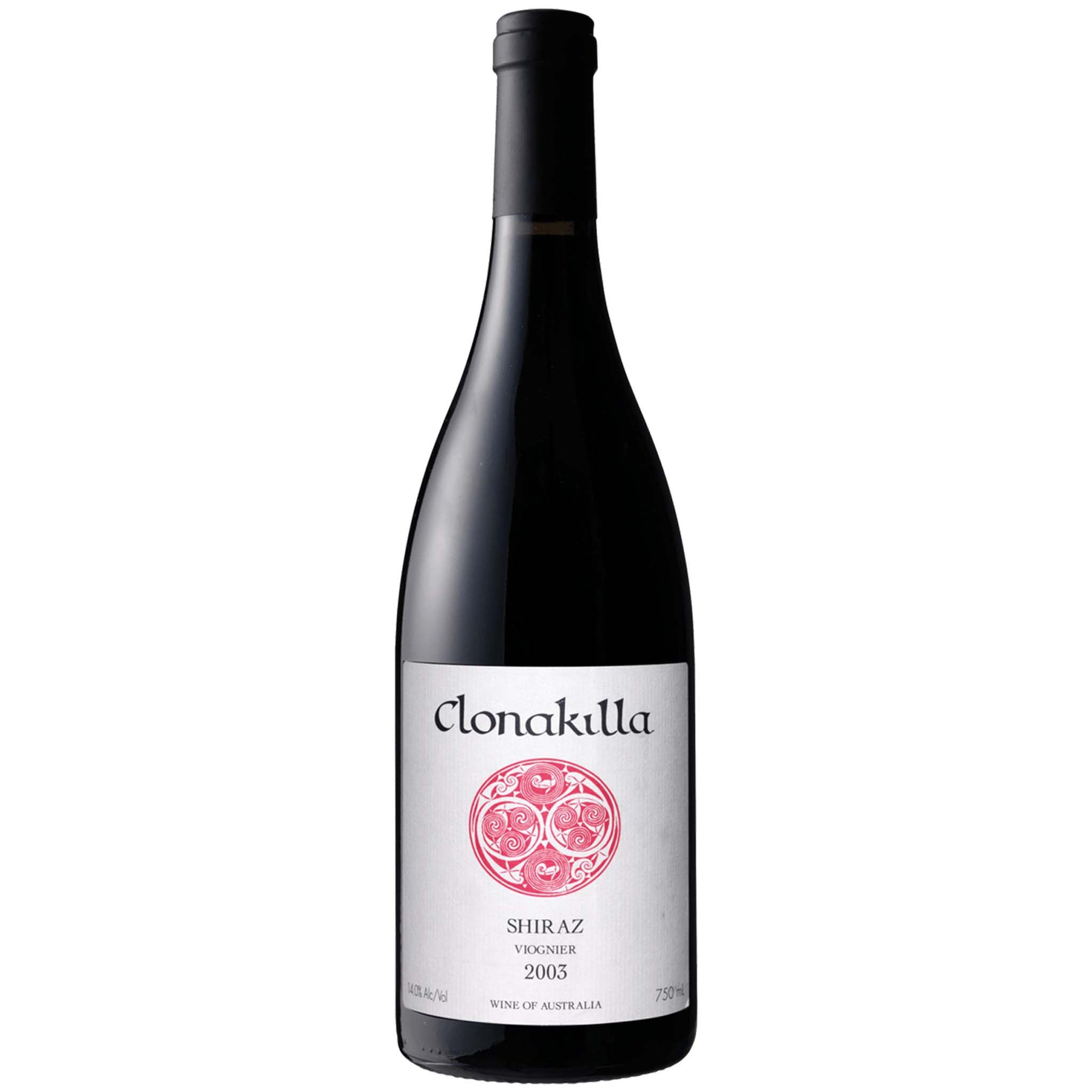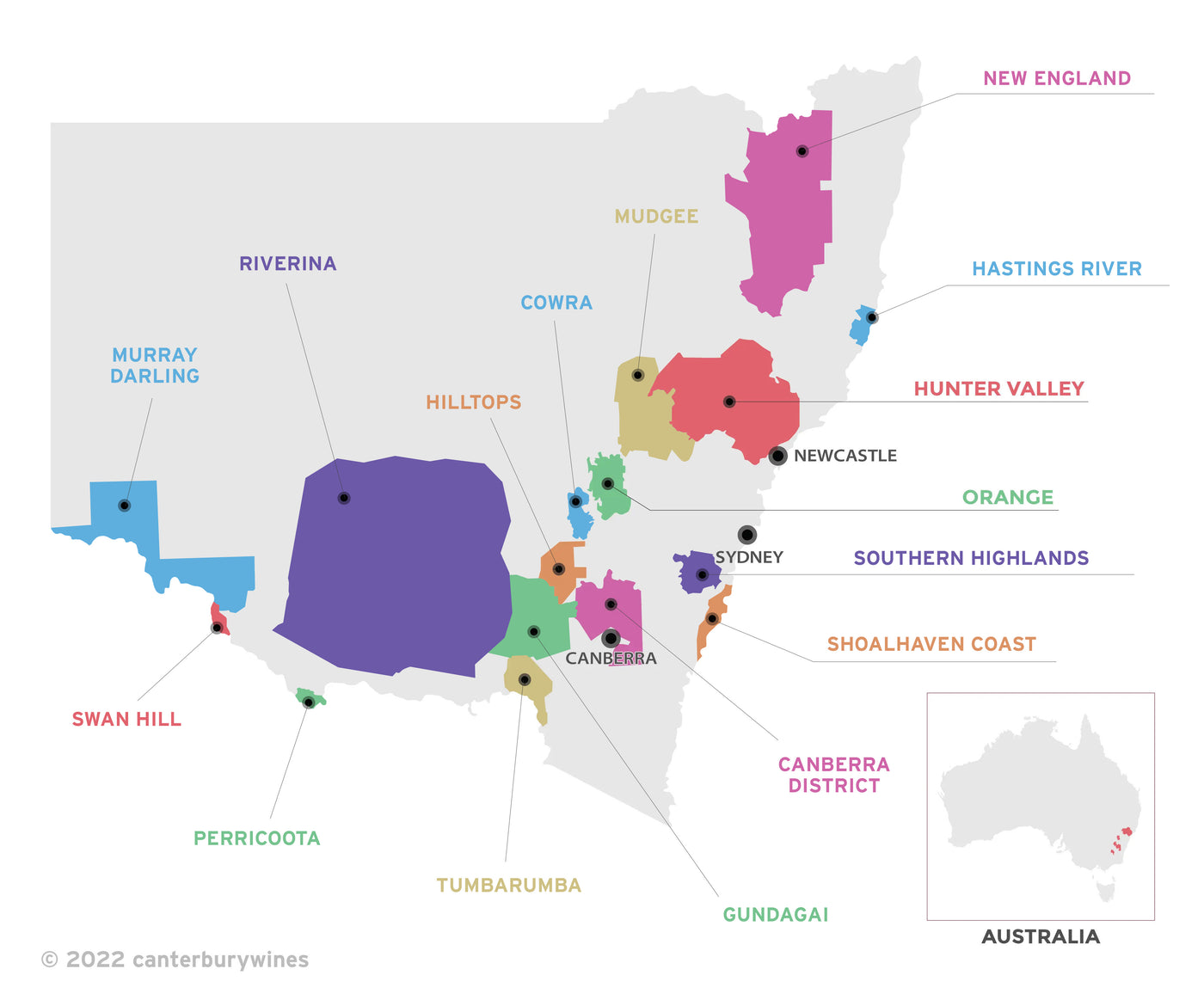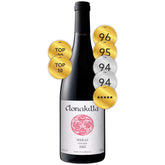

Clonakilla Shiraz Viognier 2003
Style: Red Wine
Closure: Cork
Clonakilla Shiraz Viognier 2003
Warehouse
34 Redland Drive
Vermont VIC 3133
Australia
Critic Score: 96 and ★★★★★
Alcohol: 14.0%
Size: 750 ml
Drink by: Now
Jeremy Oliver Top 10 Wines of 2004
Tim White Top 12 Wines of 2004
Philip Rich (Financial Review) Top 20 Wines of 2004
Established in 1971, Clonakilla is a small family winery at Murrumbateman dedicated to producing distinctive, handcrafted Canberra region wines. The Clonakilla Shiraz Viognier, their flagship wine, has won numerous awards and has been regularly nominated as Wine of the Year by Australia's leading Wine Critics. It is one of the great wines of Australia and is recognised as a world-class red in its own right.
"Delicious nutty flavours and scents are evident. The palate is then juicy, cherried, sappy, and delicious. In great form, with a great future ahead. Combination of spicy interest and slippery-smooth mid-palate texture is glorious. Rich for a Clonakilla. But still loaded with spice." Campbell Mattinson
"6% Viognier, 30% whole bunches. Average of two weeks on skins including 2 – 4 days pre-ferment maceration. 12 months in oak, one third new Sirugue, Francois Freres and Bossuet barrels." Clonakilla
Expert reviews
"Ripe, generous and assertive, this northern Rhone-like blend has a meaty fragrance whose viognier-derived perfume enhances the muskiness and spiciness of its earthy, red berry shiraz. Despite its sumptuous texture and powerful flavours, it's a silky, fine and elegant wine richly endowed with dark fruits and framed by firm, fine-grained tannins. Savoury, tightly focused and supremely balanced. Drink: 2011-2015+." Jeremy Oliver – 96 points and Top 10 Ten Wines of 2004
"Vibrantly fragrant and spicy; elegant, medium-bodied black cherry fruit; long and balanced." James Halliday, Halliday Wine Companion - 95 points
"In something of a scoop for Winewise we tasted the just-bottled 2003 Clonakilla Shiraz Viognier days before going to print. Although this wine won't be released for a few months, our sneak preview may encourage you to seek it out. We've commented in the past that Australian shiraz is heading in an exciting new direction, with makers in cooler areas producing exciting wines that rival those from Cote Rotie and Hermitage. Clonakilla is one of the leaders, and the 2003 is an intense yet supremely elegant shiraz with a subtly complex, slightly spicy bouquet and an exquisite fragrance derived from both varietal components. The palate is very long and very fine. Outstanding." Lester Jesberg, Winewise ★★★★★
"With an open budget, Tim White selects his best dozen wines of the year, based on quality alone... This is a red that I could drink almost any night of the week. Fragrant, intensely perfumed raspberry blackberry and apricot fruit on the nose, with a mix of white and black pepper and mace spiciness. There's forest berry fruit aplenty in the mouth, too, with apricot kernel and long, dusty dry road tannins. Also gets better as it sits in the glass." Tim White, Financial Review - 94 points and Top 12 Wines of 2004
"The Clonakilla Shiraz Viognier that set the scene, in quality terms, for Clonakilla was the 1998, but it was the run starting with the 2001 that really got things going. The 2002, from a cooler year, is an excellent wine (though idiosyncratic) and this 2003 (from a warm-to-hot year) is a rich example of what Clonakilla Shiraz Viognier is capable of.
Glossy, perfumed, smoky – a beautiful introduction to a wine. Again, delicious nutty flavours and scents are evident. The palate is then juicy, cherried, sappy, and delicious. In great form, with a great future ahead. Combination of spicy interest and slippery-smooth mid-palate texture is glorious. Rich for a Clonakilla. But still loaded with spice. Drink: 2013 - 2022." Campbell Mattinson, The Wine Front - 94 points
Awards
Jeremy Oliver Top 10 Wines of 2004
Tim White Top 12 Wines of 2004
Philip Rich (Financial Review) Top 20 Wines of 2004
About the winemaker

"As humans go, Tim Kirk is a good one; he is courteous and respectful, is generous with his time and when you talk to him, he genuinely listens. That, and he also makes very, very good wine. On a personal level, he is deeply spiritual. He doesn't hide his faith but is far from preachy. It's a pure, inclusive belief and he radiates a quiet, confident and contented joy. He's like a six-foot scholarly Friar Tuck who, instead of mead, makes Australia's best Shiraz Viognier." Wine Selectors
In 1991 Tim Kirk travelled to the Rhône Valley where he tasted the great Shiraz-based wines of Côte-Rôtie and Hermitage. The highlight of the trip was at the Guigal family winery, where Tim tasted the 1988 single vineyard Cote Roties La Landonne, La Mouline and La Turque from barrel.
This was a turning point. Tim remembers it well: "There are rare moments in a wine lover's life when you find yourself transfixed by the extraordinary beauty of what's in the glass before you, and tasting those Cote Roties was just such a revelatory moment for me. They had striking aromas; an ethereal perfume with complex, savoury dimensions, while the palate structure was different to the robust texture that Australian Shiraz wines are renowned for. These wines were finer in texture, the tannins leaving a silky impression, but with flavours that had persistence and great drive. I thought at the time that if I was ever able to produce wine from our humble vineyard at Murrumbateman that got close to that level of complexity, refinement and beauty, I would be a very happy man. I wondered if Shiraz wines approaching the best Cote Roties in style and substance could be produced in Australia. I was very fortunate that my father John had planted some Viognier at Clonakilla in the mid-eighties. I had also been impressed with what Bailey Carrodus had achieved at Yarra Yering in the Yarra Valley with his Dry Red No. 2. So from the 1992 vintage onwards we set about making a Shiraz Viognier blend from our Murrumbateman vineyard.”
Tim's trip to the Rhône Valley was a career defining trip. A year later the first Clonakilla Shiraz with a small amount of co-fermented Viognier was made and received critical acclaim from a number of luminaries. Tim decided to leave his teaching post at a Jesuit school and became the winemaker and General Manager at Clonakilla.
In 1999, in a shock result for the Hunter Valley dominated NSW wine industry, the 1998 Clonakilla Shiraz Viognier was named New South Wales Wine of the Year. Numerous awards have since followed and the wine has regularly been nominated as Wine of the Year by Australia's leading Wine Critics. The Clonakilla Shiraz Viognier is now widely celebrated as one of the great reds of Australia and recognised as a world-class red in its own right.
In 2007, encouraged by the worldwide success of the Shiraz Viognier, Tim decided to release a straight Shiraz from the 2006 vintage (from the same estate vines that produce the Shiraz Viognier). The Syrah presents as a darker, more brooding wine than the Shiraz Viognier with a distinct wild berry, potent spice character. This is the Hermitage to the Shiraz Viognier's Côte-Rôtie. It's also rare. No more than 300 dozen are made each year.
In 2009 Tim Kirk was named Winemaker of the Year by Nick Stock in the Penguin Good Wine Guide. This was followed in 2013 when he was named Gourmet Traveller Wine magazine's Winemaker of the Year. It was the third time he had been shortlisted for this prestigious award.
The overriding principle that governs the work at Clonakilla is that the winemaking has to respect the fruit. In Tim's view, "The task of the winemaker is to capture something that is present in the fruit; something good, unique, worthy of inspection, perhaps even beautiful. Carefully grown grapes from a noble site deserve the opportunity to express themselves in as pure a form as possible. It is important to resist the temptation to bury the fruit in too much winemaking artifice. The winemaking inputs we bring should serve the purpose of capturing the personality of the fruit, rather than imposing the winemaker's vision for what the thing is supposed to taste like."
About the winery

In 1971 John Kirk purchased an 18ha farm near the village of Murrumbateman, 40km north of Canberra. He named the property Clonakilla (‘meadow of the church') after his grandfather's farm in County Clare, Ireland. The Vineyard was established the same year, on soil consisting of sandy clay loams over a base of decomposed granite. John produced the Canberra District's first commercial vintage in 1976 – a Riesling Sauvignon Blanc and a Cabernet Shiraz. From 1978 to the present, the Clonakilla Vineyard has gradually expanded with Shiraz, Riesling and Viognier making up the bulk of the vineyard, which now covers 16.2ha.
John first planted Shiraz at Clonakilla in 1972. Through the seventies and eighties the Shiraz was blended with Cabernet Sauvignon in traditional Australian style. In 1990 it was decided to keep the Shiraz component separate. The Clonakilla 1990 Shiraz went on to win two gold medals and two trophies. James Halliday described it as "a tour de force in spicy/peppery varietal character”. Needless to say, the Kirks began to see Murrumbateman Shiraz in a new light.
In 1991 Tim Kirk, John's son, made a career defining trip to the Côte-Rôtie in the Rhone Valley and the idea of a Clonakilla Shiraz Viognier blend was born. A year later the first Clonakilla Shiraz with a small amount of co-fermented Viognier was made and received critical acclaim from a number of luminaries. Tim decided to leave his teaching post at a Jesuit school and became the winemaker and General Manager at Clonakilla.
Demand for their wines soon outstripped supply and in 1998 Tim and his wife Lara Kirk purchased the 20ha block next to Clonakilla and planted Shiraz and Viognier on the warm North East facing site. In 2007 the Kirk family purchased another adjoining property and planted another 1.8ha of shiraz, plus 0.4ha of grenache, mourvèdre and cinsault.
Meanwhile, the range of wines at Clonakilla gradually expanded. In 2000, the first Clonakilla Hilltops Shiraz was made from grapes grown around the Town of Young in New South Wales. In 2007 the first Clonakilla O'Riada Shiraz, from fruit purchased from other Canberra vineyards, was made in response to the loss of 90% of the estate fruit to frost. In subsequent years the O'Riada Shira also included the estate fruit that just misses the cut for selection in the Shiraz Viognier.
In the same year, encouraged by the worldwide success of the Shiraz Viognier, Tim decided to release a straight Shiraz (Syrah) from the same estate vines that produce the Shiraz Viognier. The Syrah presents as a darker, more brooding wine than the Shiraz Viognier with a distinct wild berry, potent spice character. This is the Hermitage to the Shiraz Viognier's Côte-Rôtie. It's also rare. No more than 300 dozen are made each year.
It has been a remarkable journey for Clonakilla. When John Kirk planted the first vines in 1971 he had no idea that his vineyard would one day be celebrated as one of the best in the country. Over time something important has become clear - Murrumbateman and Shiraz (in the right hands) are one of those rare combinations in the world of wine that can produce something truly exciting.

New South Wales
New South Wales is home to more than 500 wineries across 16 wine regions that produce a range of extremely diverse wines. The regions are Canberra District, Cowra, Gundagai, Hastings River, Hilltops, Hunter Valley, Mudgee, Murray Darling, New England, Orange, Perricoota, Riverina, Southern Highlands, Shoalhaven Coast, Swan Hill and Tumbarumba.
Hunter Valley is New South Wales' best known wine region and has long stolen much of the spotlight . It is also Australia’s oldest continuous wine region - the first vineyard at Wyndham Estate was established in 1828 using cuttings supplied by viticulturist James Busby, widely considered the father of Australian wine. Semillon is perhaps the most iconic wine of the Hunter Valley and is among the greatest and most distinctive wines of Australia - if not the world.
New South Wales' wine regions have a wide range of microclimates. The Great Dividing Range has a substantial influence on the climate of many of the viticultural areas. The regions of higher elevation, such as Canberra District, Canberra District, Orange and Tumbarumba have cooler climates with more continental influences. These regions are responsible for some of the State's most enticing chardonnay, shiraz, cabernet sauvignon, riesling and sauvignon blanc. They, together with the Hunter Valley, which by contrast, is very warm, with high humidity and a large amount of rainfall during the growing and harvest season, produce the bulk of the high quality wine in New South Wales.

